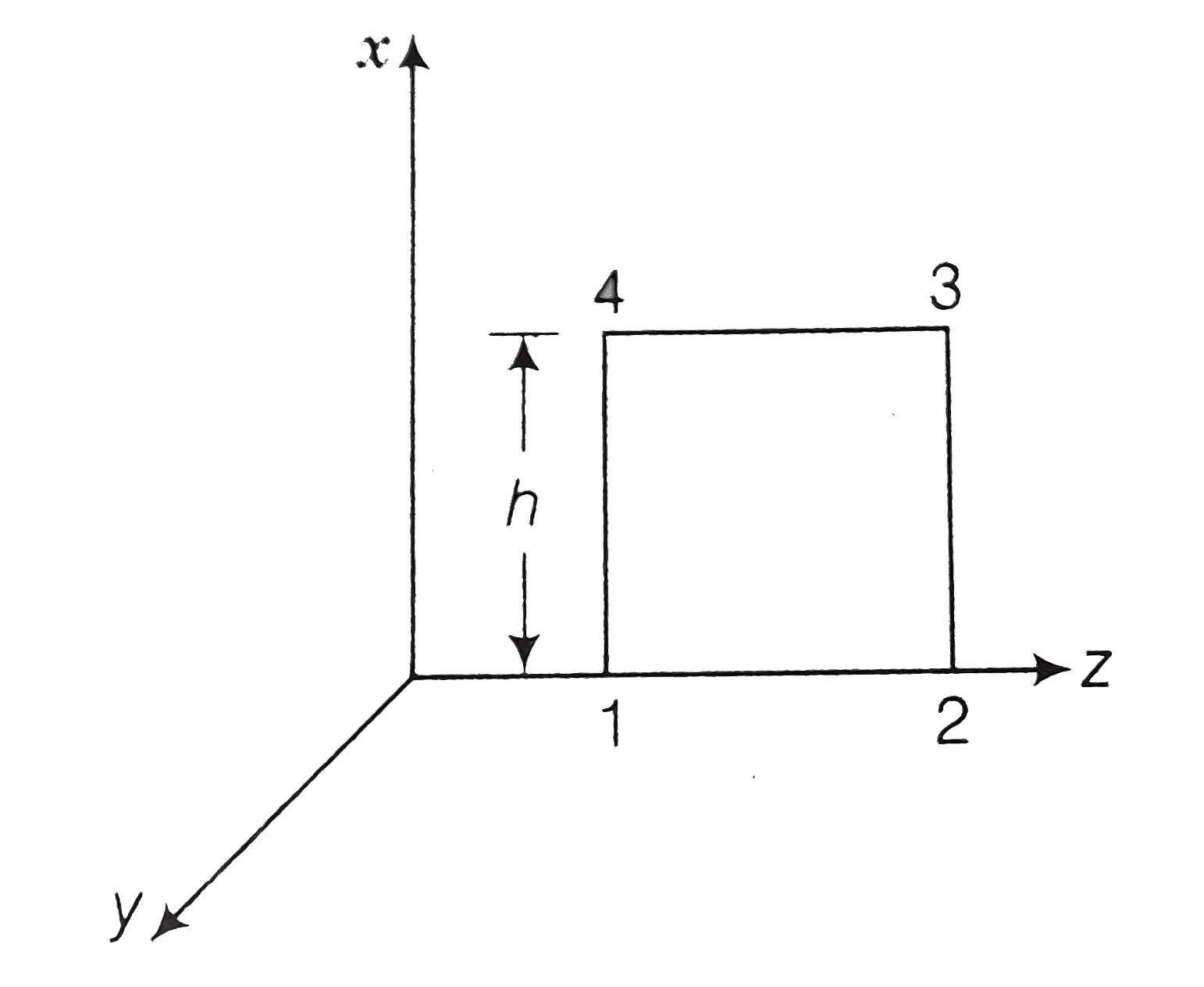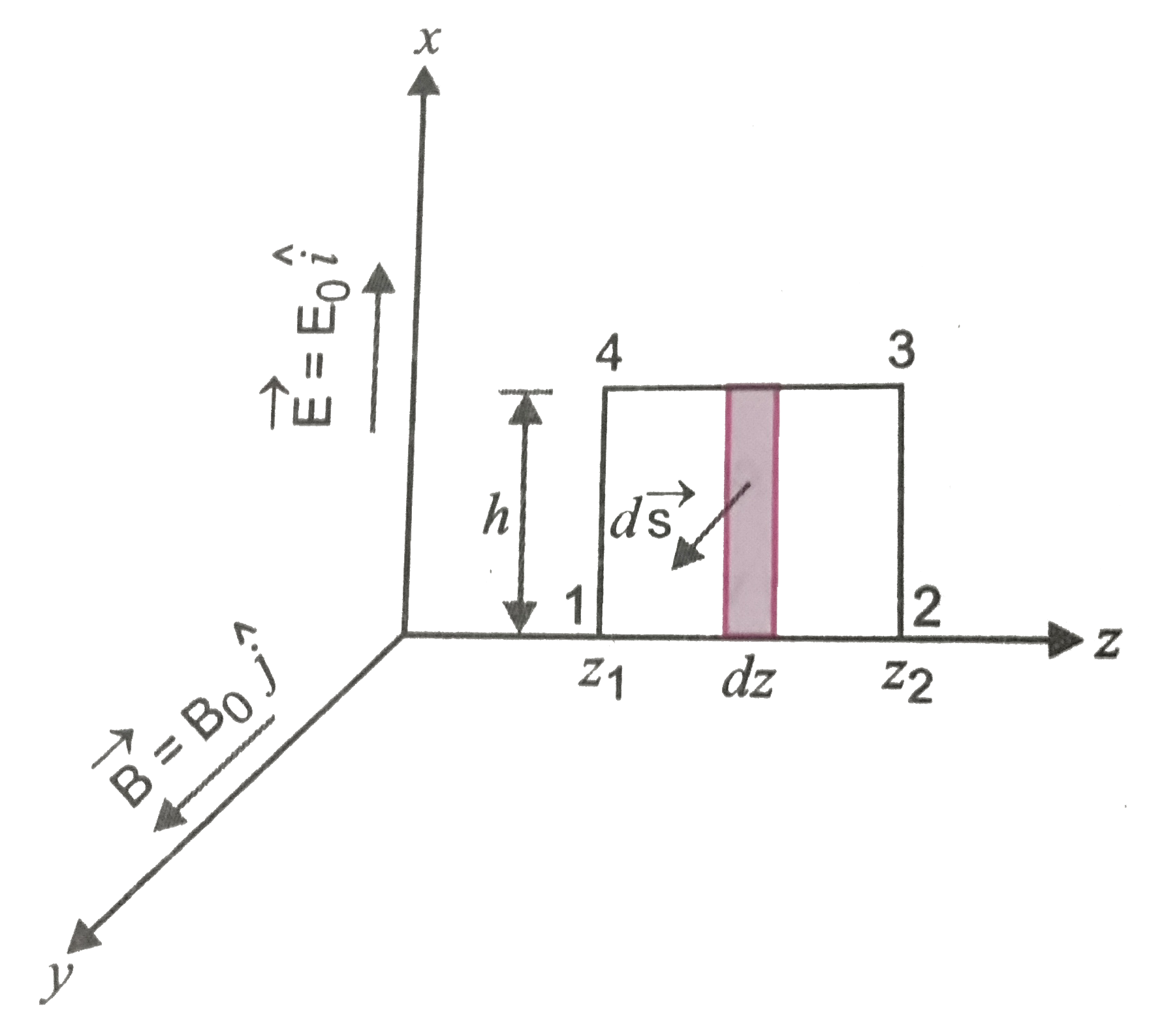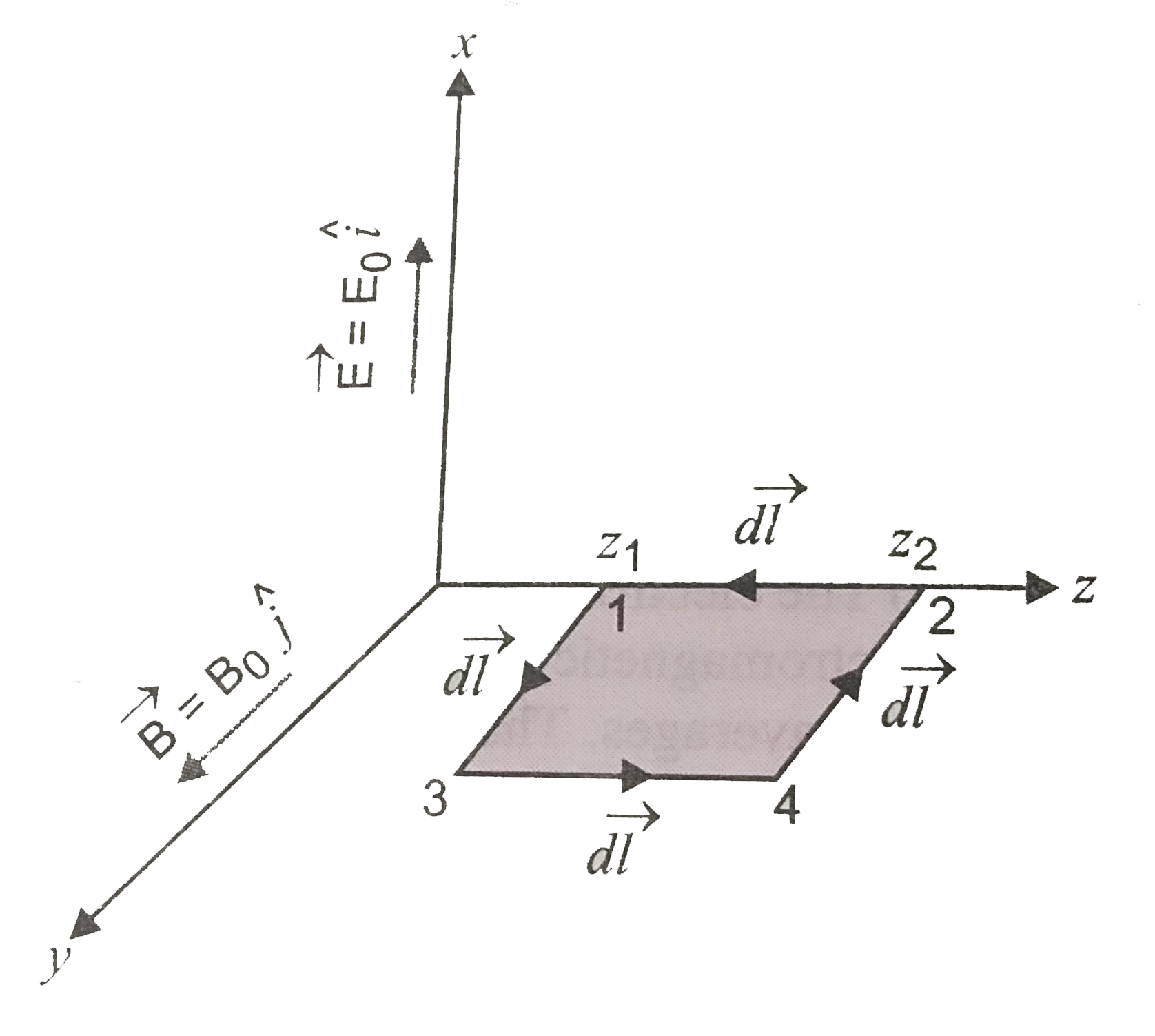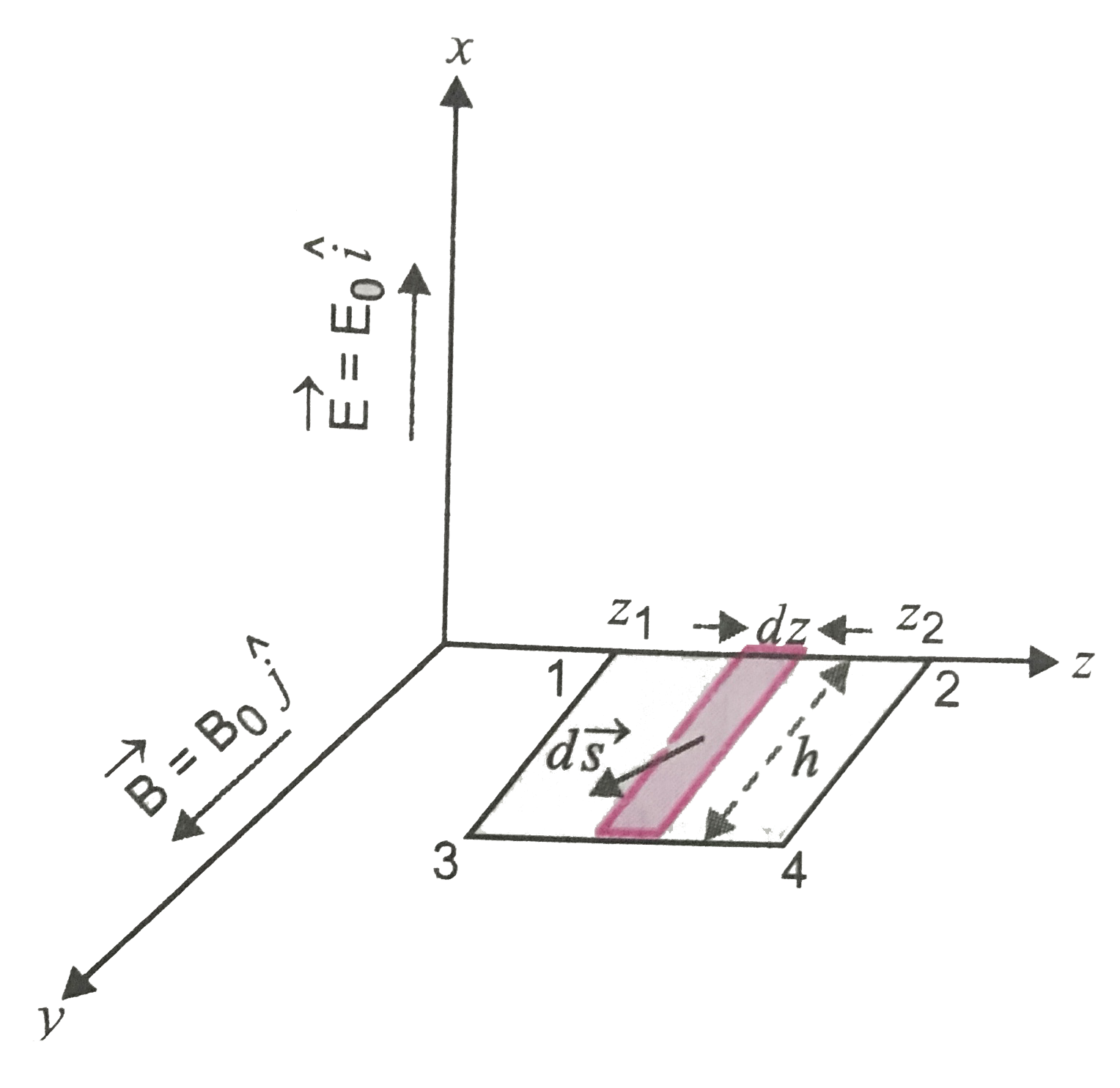A plane EM wave travelling in vacuum along z-direction is given by E=E0 sin (kz−ωt)ˆi and B=B0 sin (kz−ωt)ˆj
(i) Evaluate ∫E.dl over the rectangular loop 1234 shown in figure.
(ii) Evaluate ∫B.ds over the surface bounded by loop 1234.
(iii) Use equation ∫E.dl=−dϕBdt to prove E0B0=c.
(iv) By using similar proces and the equation
∫B.dl=μ0I+ε0dϕEdt, prove that c1√μ0ε0

(i) During the propagation of e.m. wave along z-axis, let electric field vector →E be along x-
axis and magnetic field vector →B be along y-axis i.e., →E=E0ˆiand→B=B0ˆj. Line
integral of →E over the closed rectangular, path 1234 in x-z plane is
∮→E.→dl=∫21→E.→dl+∫32→E.→dl+∫43→E.→dl+∫14→E.→dl
=∫21Edlcos90∘+∫32Edlcos0∘+∫43Edlcos90∘+∫14Edlcos180∘
=0+Ez2h+0−Ez1h=Ez2−Ez1=E0h[sin(kz2−ωt)−sin(kz1−ωt)]......(i)
(ii) For evaluting ∮→B.→dl over the surface bounded by
loop1234, let us consider a rectangle 1234 be made of small
strips. One small strip of area ds=h dz is shown in fig.
∮Surface bounded by strips 1234→B.→ds=∮Bdscos0∘=∮Bds
=∫z2z1B0sin(kz2−ωt)hdz
=−B0hk[cos(kz2−ωt)−cos(kz1−ωt).....(ii)
(iii) Given, ∮→E.→dl=−dϕBdt=−ddt∮→B.→ds
Puting the values from (i) and (ii), we get,
E0h[sin(kz2−ωt)−sin(kz1−ωt)]
=−ddt[−B0hk{cos(kz2−ωt)−cos(kz1−ωt)}]
=B0hkω[sin(kz2−ωt)−sin(kz1−ωt)}]
or E0=B0ωk=B0c(∵ωk=c)orE0/B0=c
(iv) For evaluting ∮→B.→dl, let us consider a loop 1342
in y-z plane as shown in fig.
∮→B.→dl=∮31→B.→dl+∮43→B.→dl+∮24→B.→dl+∮12→B.→dl
∫31Bdlcos0∘+∫43Bdlcos90∘+∫24Bdlcos180∘+∫12Bdlcos90∘=∫31Bdl+0−∫24Bdl+0
=Bz1h−Bz2h=h(Bz1−Bz2)=B0h[sin(kz1−ωt)−sin(kz2−ωt)]....(iii)
To evalute ϕE=∮→E.→ds, let us consider the rectangle
1342 to be made up of strips, each of area ds=hdz. fig.
ϕE=∮→E.→ds=∮Edscos0∘=∮Eds
∫z2z1E0sin(kz1−ωt)hdz
=−E0hk[cos(kz2−ωt)−cos(kz1−ωt)]
∴dϕEdt=E0hωk[sin(kz1−ωt)−sin(kz2−ωt)....(iv)
In the relation, ∮→B.→dl=μ0[1+ε0dϕEdt]
I is the conduction current. The value of I=0 (in vacuum) ∴∮→B.→dl=μ0ε0dϕEdt
Putting values form (iii) and (iv), we get
B0h[sin(kz1−ωt)−sin(kz2−ωt)]=μ∈_0E0hωk[sin(kz1−ωt)−sin(kz2−ωt)]
or B0h=μ0∈0E0hωkorE0B0ωk=1μ0∈0[asE0B0=candω=ck]
∴cckk=1μ0∈0orc2=1μ0∈0orc=1√μ0∈0



Topper's Solved these Questions
- BOOK - PRADEEPCHAPTER - ELECTROMAGNETIC WAVESEXERCISE - Higher order Thinking skills2videos
ELECTROMAGNETIC WAVES
- BOOK - PRADEEPCHAPTER - ELECTROMAGNETIC WAVESEXERCISE - Value based questions5videos
ELECTROMAGNETIC WAVES
- BOOK - PRADEEPCHAPTER - ELECTROMAGNETIC WAVESEXERCISE - short answer question2videos
ELECTROMAGNETIC WAVES
- BOOK - PRADEEPCHAPTER - ELECTROMAGNETIC INDUCTION & ALTERNATING CURRENTEXERCISE - Multiple Choice Questions1videos
ELECTROMAGNETIC INDUCTION & ALTERNATING CURRENT
- BOOK - PRADEEPCHAPTER - ELECTRONIC DEVICESEXERCISE - Fill in the Blanks1videos
ELECTRONIC DEVICES
Similar Questions
A plane EM wave travelling in vacuum along z-direction is given by E=E0 sin (kz−ωt)ˆi and B=B0 sin (kz−ωt)ˆj
(i) Evaluate ∫E.dl over the rectangular loop 1234 shown in figure.
(ii) Evaluate ∫B.ds over the surface bounded by loop 1234.
(iii) Use equation ∫E.dl=−dϕBdt to prove E0B0=c.
(iv) By using similar proces and the equation
∫B.dl=μ0I+ε0dϕEdt, prove that c1√μ0ε0
 View Solution
View SolutionA plane EM wave travelling along z-direction is described by E=E0sin(kz−ωt)ˆi and B=B0sin(kz−ωt)ˆjThe time averaged intensity of the wave is given by I(av)=(18cɛ0E20)α. Find α
View Solution
Knowledge Check
- Question 1 - Select One
A electromagnetic wave going through a medium is given by E=E0sin(kx–ωt)andB=B0sin(kx–ωt) then
AE0k=B0ωBIf Electric is in Z direction them magnetic field should be in -y direction.CBoth ‘A’ and ‘B’ are correctDOnly A is correct - Question 2 - Select One
Dimensions of ε0dϕEdt are same as that of
A[AT]B[A]C[ML2T−2]D[ML−1T−2] - Question 3 - Select One
The maxwell’s equation :
∮→B.→dl=μ0(i+ɛ0.dϕEdt) is a statement of -AFaraday’s law of inductionBModified Ampere’s lawCGauss’s law of electricityDGauss’s law of magnetism
A plane EM wave travelling along z direction is described by
E=E0sin(kz−ωt)ˆiandB=B0sin(kz−ωt)ˆj.
show that
(i) The average energy density of the wave is given by uav=14ε0E20+14B20μ0.
(ii) The time averaged intensity of the wave is given by Iav=12cε0E20.View SolutionDimensions of ε0dϕEdt are same as that of
View SolutionAn electromagnetic wave travelling along z-axis is given as E=E0 cos (kz−ωt). Choose the correct options from the following
View SolutionAn electromagnetic wave is propagating in vacuum along z-axis, the electric field component is given by Ex=E0sin(kz−ωt). Then magnetic components is
View SolutionAn electromagnetic wave is propagating in vacuum along z-axis, the electric field component is given by Ex=E0sin(kz−ωt), then magnetic component is
View Solution

